10 Must Visit Temples in Bangkok for International Tourists
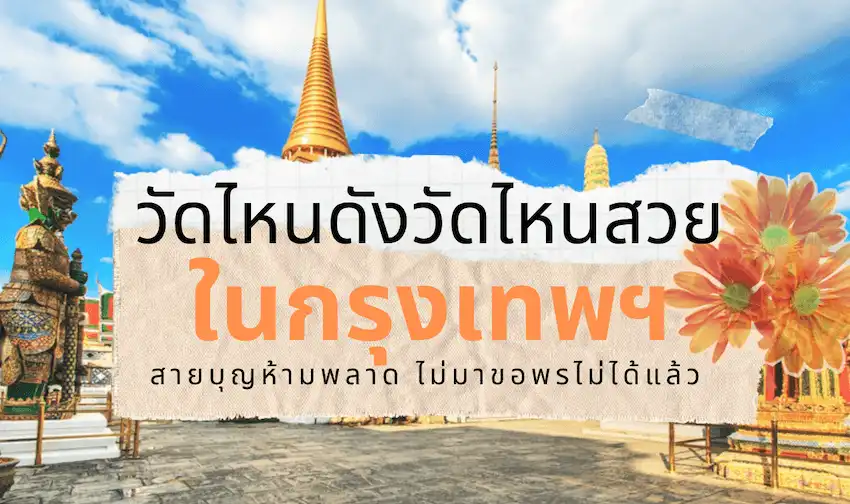
Rating: 5/5 (1 votes)
Bangkok attractions
Attractions in Thailand
10 Must-Visit Temples in Bangkok for International Tourists Important Temples in Bangkok: Connecting Religion, Culture, and History Bangkok, the capital city of Thailand, is not only a central hub for economics and politics but also home to many significant temples that reflect the country’s history, religion, and culture. These temples serve not only as important places of worship but also as key tourist attractions where both Thai and international visitors can experience different facets of Thailand. Here are some of the most important temples in Bangkok that you shouldn’t miss:
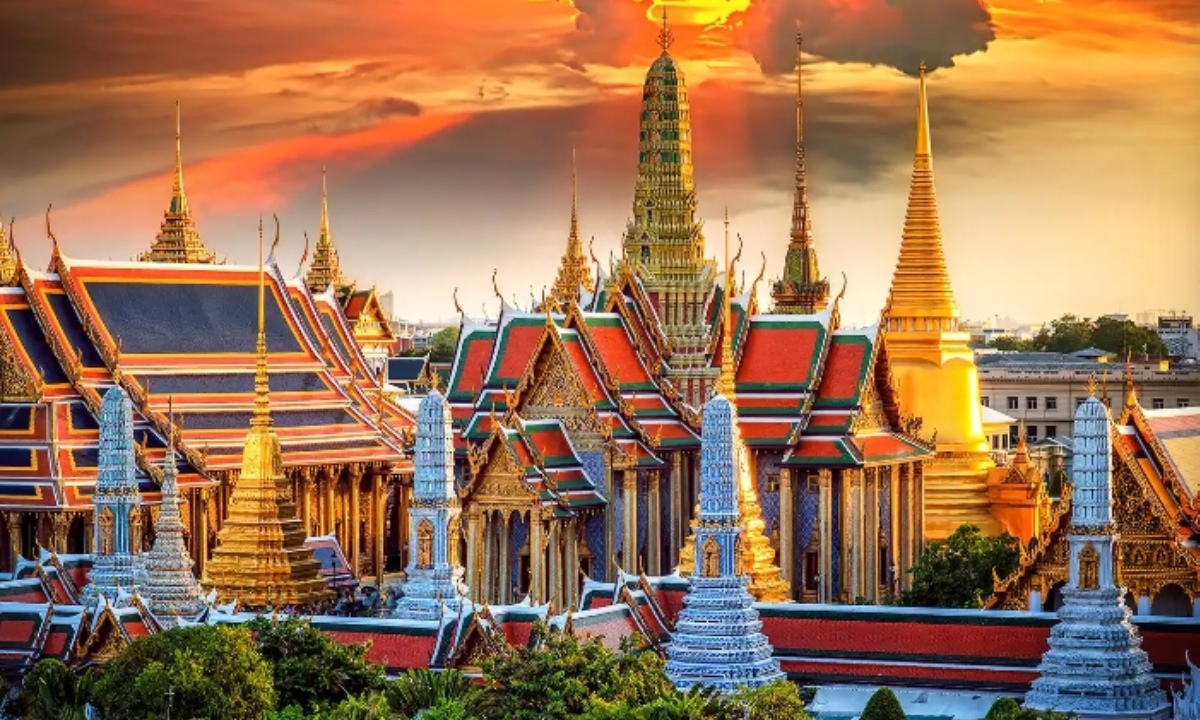
1. Wat Phra Kaew (Temple of the Emerald Buddha) - The Center of Faith
Wat Phra Kaew, commonly known as the Temple of the Emerald Buddha, is the most famous temple in Thailand. Located within the Grand Palace complex, Wat Phra Kaew was established by King Rama I to house the Emerald Buddha, a highly sacred and symbolic Buddha statue representing the spiritual and political heart of the country.
The Emerald Buddha is revered as a symbol of stability and unity for the Thai Kingdom. Wat Phra Kaew also hosts many important royal ceremonies, including coronations. Visitors to Wat Phra Kaew can admire the intricate architecture of traditional Thai design, including the meticulously decorated main hall (ubosot) and the iconic central spire (prang), which are integral to the temple's grand appearance.
Address: Located in the Grand Palace area, Na Phra Lan Road, Phra Borom Maha Ratchawang, Phra Nakhon, Bangkok.
How to get to Wat Phra Kaew:
BTS Skytrain: Get off at National Stadium Station and transfer to public transportation to reach Wat Phra Kaew.
Alternatively, get off at Saphan Taksin Station, take a ferry from Saphan Taksin Pier to Tha Chang Pier, and then walk to Wat Phra Kaew.
Chao Phraya Express Boat: Get off at Tha Chang Pier, which is close to Wat Phra Kaew. You can walk from Tha Chang Pier to the temple in a short distance.
Public Buses: Bus lines that pass by Wat Phra Kaew include lines 1, 25, 44, 47, 82, and 503.
Taxi or Private Car: If traveling by taxi or private car, you can pin "Wat Phra Si Rattana Satsadaram" in navigation apps. However, parking might need to be done in nearby public parking areas as parking around the temple might be limited.
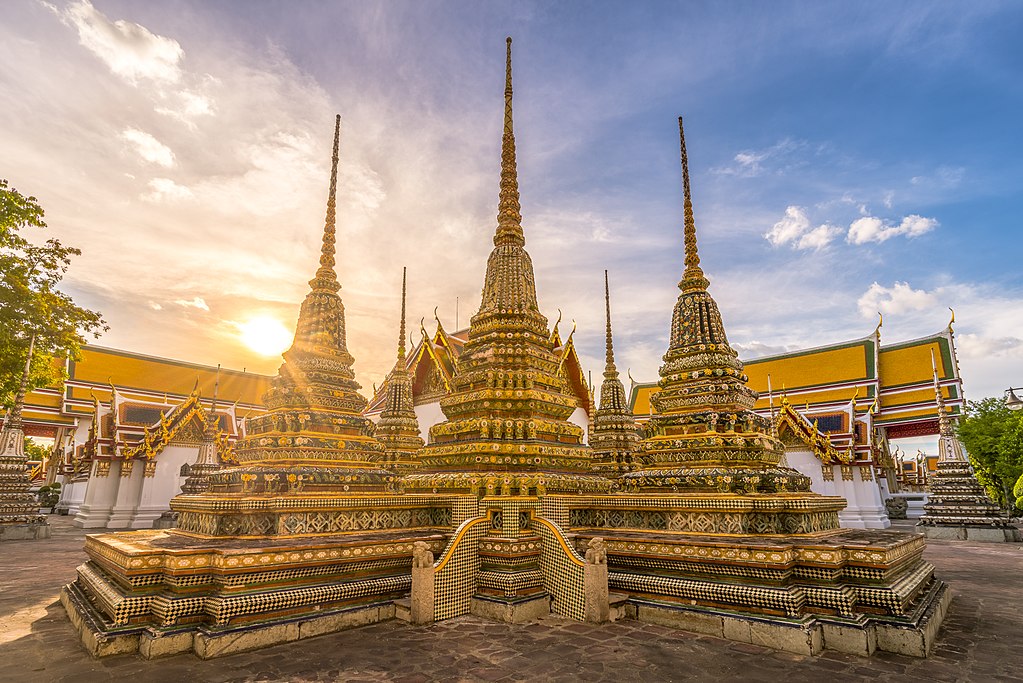
2. Wat Pho (Temple of the Reclining Buddha) - A Hub for Learning and Thai Medicine
Wat Pho, also known as Wat Phra Chetuphon, is renowned for its extensive collection of Thai medical texts and its position as the birthplace of Thai massage. Located near the Grand Palace, Wat Pho is the largest temple in Bangkok and is famous for the Reclining Buddha statue, which measures 46 meters long and 15 meters high. This statue symbolizes peace and compassion.
Wat Pho is also a center for traditional Thai medicine and massage, with the temple housing one of Thailand's earliest medical schools. Visitors can explore the temple's beautiful architecture, including glazed ceramic decorations and intricate murals, and even experience traditional Thai massage sessions offered at the temple.
Address: 2 Sanam Chai Road, Phra Borom Maha Ratchawang, Phra Nakhon, Bangkok 10200
How to get to Wat Pho:
BTS Skytrain: Get off at Saphan Taksin Station and take a ferry to Tha Tien Pier. From Tha Tien Pier, you can walk to Wat Pho in just a few minutes.
Chao Phraya Express Boat: Get off at Tha Tien Pier, which is close to Wat Pho. You can walk from the pier to the temple easily.
Public Buses: Bus lines passing by Wat Pho include lines 1, 3, 6, 9, 12, 44, 47, 53, and 82.
Taxi or Private Car: If traveling by taxi or private car, you can use navigation apps to pin "Wat Pho" or "Wat Phra Chetuphon." There is parking available near the temple, but parking space may be limited during peak tourist times.
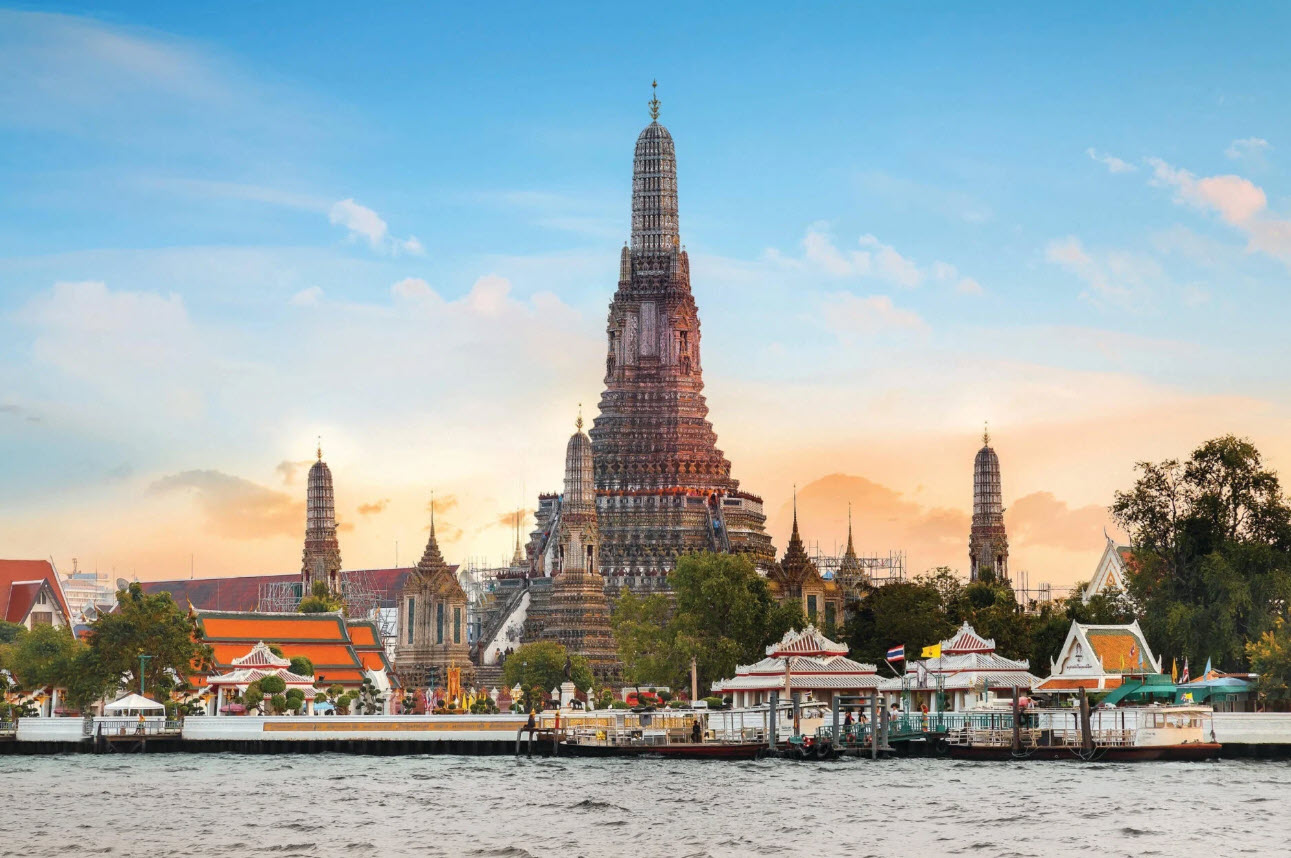
3. Wat Arun (Temple of Dawn) - A Bangkok Landmark
Wat Arun, or the Temple of Dawn, is one of Bangkok’s most recognizable landmarks. Situated on the banks of the Chao Phraya River, Wat Arun is often hailed as the most beautiful temple in Bangkok. Its central feature is the massive central spire, or prang, which stands 70 meters tall and is adorned with colorful porcelain tiles and glass.
The temple’s beauty is particularly striking during sunrise and sunset, when the light plays off the porcelain tiles and the spire appears to glow. Visitors can climb up the central spire for a panoramic view of Bangkok and the river. Wat Arun’s architecture and decoration showcase traditional Thai artistry, and its location offers a serene retreat from the bustling city.
Address: 34 Arun Amarin Road, Wat Arun, Bangkok Yai, Bangkok 10600
How to get to Wat Arun:
Chao Phraya Express Boat: Take the Chao Phraya Express Boat and get off at Tha Tien Pier (Tha Tien), which is right next to Wat Arun. This is the most convenient and popular way to travel to Wat Arun.
BTS Skytrain: Get off at Saphan Taksin Station and take a ferry across the river to Tha Tien Pier. From Tha Tien Pier, you can walk directly to Wat Arun.
Public Buses: Bus lines that pass near Wat Arun include lines 57, 81, 91, and 146.
Taxi or Private Car: If traveling by taxi or private car, you can use navigation apps to pin "Wat Arun Rajawararam." There is parking available near the temple, but it is advisable to check as parking might be limited at times.
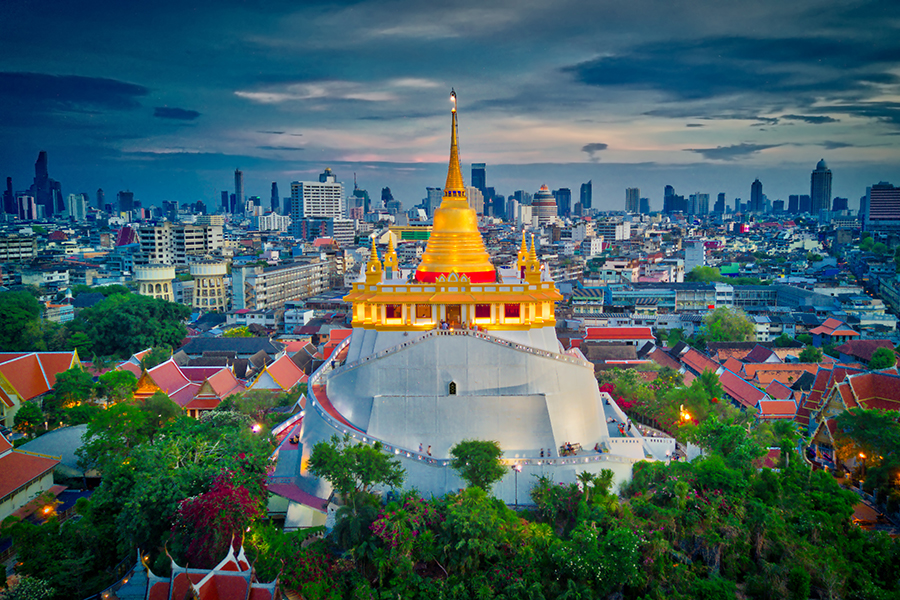
4. Wat Saket (Golden Mount Temple) - A Temple with a Golden Mountain
Wat Saket, also known as Wat Saket Ratcha Wora Maha Wihan, is famed for its Golden Mount (Phu Khao Thong), an artificial hill topped with a golden chedi. Located in the old city, the temple’s construction dates back to the Ayutthaya period and was completed during the reign of King Rama III.
The Golden Mount stands 80 meters tall, and visitors can climb up the winding staircase to reach the top, where they are rewarded with a stunning view of the city. The temple is also known for the annual Golden Mount Festival held in November and December, which draws crowds for religious ceremonies and cultural events.
Address: 344 Bamrung Mueang Road, Ban Bat, Bangkok Noi, Bangkok 10700
How to get to Wat Saket:
MRT: Get off at Sam Yot Station and take a taxi or public bus to Wat Saket, which is not far from the station.
Public Buses: Bus lines passing near Wat Saket include lines 19, 57, 83, 146, and 149.
Chao Phraya Express Boat: Get off at Memorial Bridge Pier (Saphan Phut) and transfer to public transportation or taxi to Wat Saket.
Taxi or Private Car: You can use Bamrung Mueang Road to reach Wat Saket, and parking is available at the temple or in nearby areas.
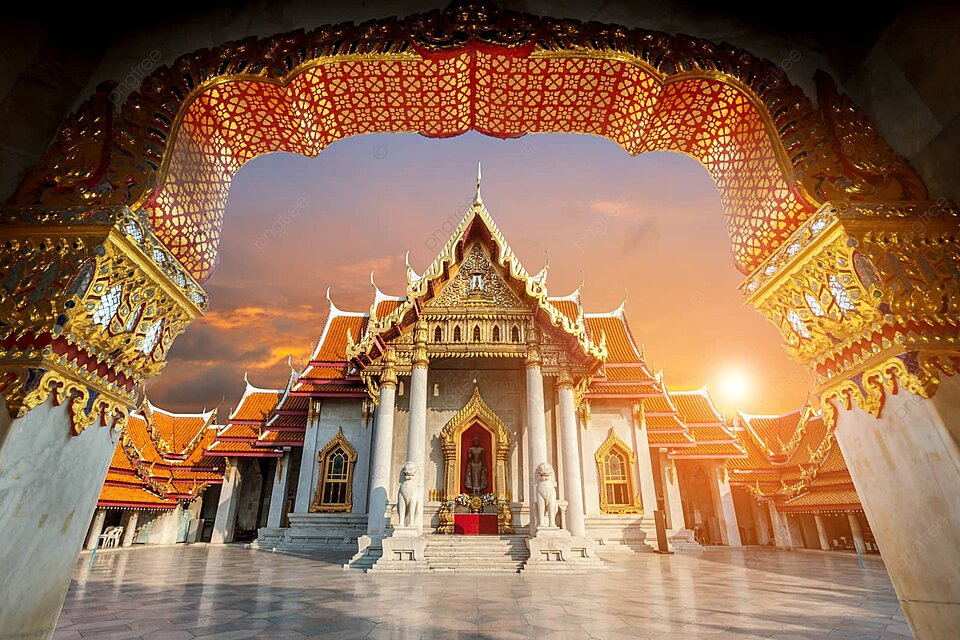
5. Wat Benchamabophit (Marble Temple) - An Architectural Masterpiece
Wat Benchamabophit, commonly known as the Marble Temple, is noted for its striking architecture and the use of Italian marble in its construction. Located in Dusit, near the Grand Palace, the temple was built during the reign of King Rama V.
The temple’s main hall, or ubosot, is constructed from white Italian marble and is surrounded by beautiful gardens and serene courtyards. Inside, visitors can see a large statue of the Buddha, and the temple’s design blends traditional Thai elements with Western influences. Wat Benchamabophit is renowned for its elegance and is a significant site for both worship and tourism.
Address: 44 Sanam Suea Road, Dusit, Dusit District, Bangkok 10300
How to get to Wat Benchamabophit:
MRT: Get off at Dusit Station and walk to Wat Benchamabophit, which is not far from the station.
Public Buses: Bus lines passing near Wat Benchamabophit include lines 18, 30, 39, 52, 54, 56, 62, 97, and 503.
BTS Skytrain: Get off at Mo Chit Station and take a taxi or public bus to Wat Benchamabophit.
Taxi or Private Car: You can use Sanam Suea Road to reach Wat Benchamabophit, and parking is available at the temple or in nearby areas.
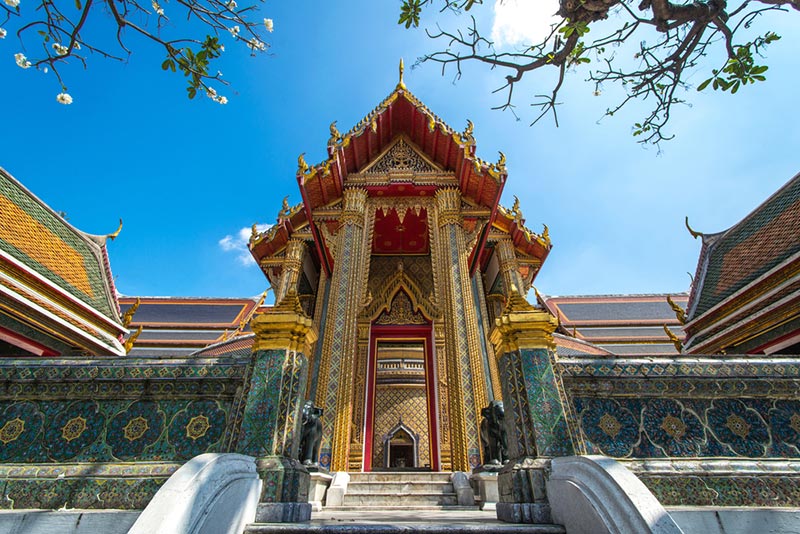
6. Wat Ratchabophit Sathit Maha Simaram Ratcha Wora Wihan - A Temple for Study and Preservation
Wat Ratchabophit Sathit Maha Simaram Ratcha Wora Wihan, often simply referred to as "Wat Ratchabophit," plays a significant role in the study and preservation of Buddhism. Located in the Phra Nakhon district, this temple has a long history dating back to the reign of King Rama V, who founded it in 1869.
The architecture of Wat Ratchabophit is a harmonious blend of Thai and European styles. The main ordination hall (ubosot) is circular in shape, with multiple-tiered roofs adorned with glazed tiles and beautiful stained glass. The temple also features murals that depict religious stories and the history of Thailand, offering visitors a deep understanding of Thai art and culture.
Wat Ratchabophit is also a place where visitors can study and gain a profound understanding of Buddhist teachings and discipline. The temple regularly hosts activities and training related to Buddhism, allowing interested visitors to participate and learn from monks and experts with deep knowledge of the Dharma.
Visitors to Wat Ratchabophit will experience a serene atmosphere and the unique beauty of Thai art, while also gaining insight into Buddhism from a different perspective. This makes a visit to Wat Ratchabophit an enriching and memorable experience.
Address: 2 Fuang Nakhon Road, Wat Ratchabophit, Phra Nakhon, Bangkok 10200
How to get to Wat Ratchabophit:
MRT: Get off at Sam Yot Station and walk or take a taxi or public bus to Wat Ratchabophit, which is not far from the station.
BTS Skytrain: Get off at Saphan Taksin Station and take a ferry to Ratchini Pier. From there, take a taxi or walk to Wat Ratchabophit.
Public Buses: Bus lines passing near Wat Ratchabophit include lines 10, 12, 42, 56, and 96.
Taxi or Private Car: Use Ratchadamnoen Klang Road and Fuang Nakhon Road to reach Wat Ratchabophit. You can pin "Wat Ratchabophit" in navigation apps. There is parking available around the temple.
Wat Ratchabophit is located near other significant sites like Wat Phra Kaew and Wat Pho, making it convenient to plan a visit to these important landmarks in a single trip.

7. Wat Ratchapradit Sathit Maha Simaram - A Temple Associated with Thai Monarchs
Wat Ratchapradit Sathit Maha Simaram, established by King Rama IV, is notable for its historical and religious significance. Located in the heart of Bangkok, the temple is closely associated with the Chakri Dynasty and has been a site for various royal ceremonies.
The temple features a unique chedi and beautifully decorated main hall. The architecture combines traditional Thai designs with European influences, reflecting the era’s cultural exchange. Visitors to Wat Ratchapradit can gain insights into its role in royal rituals and its historical contributions to the Thai monarchy.
Address: 2 Sanam Chai Road, Phra Borom Maha Ratchawang, Phra Nakhon, Bangkok 10200
How to get to Wat Ratchapradit:
BTS Skytrain: Get off at Saphan Taksin Station and take a ferry to Tha Chang or Tha Tien Pier. From there, take a taxi or walk to Wat Ratchapradit, which is not far.
MRT: Get off at Sam Yot Station and take a taxi or public bus to Wat Ratchapradit.
Public Buses: Bus lines passing near Wat Ratchapradit include lines 2, 3, 12, 15, 25, 32, and 47.
Taxi or Private Car: Use Ratchadamnoen Klang Road or Sanam Chai Road to reach Wat Ratchapradit. Parking is available at the temple, but it's advisable to check for parking availability as it may be limited during busy times.
Wat Ratchapradit is located near important sites such as Wat Phra Kaew and the Grand Palace, making it convenient for planning a trip to these significant landmarks in Bangkok.
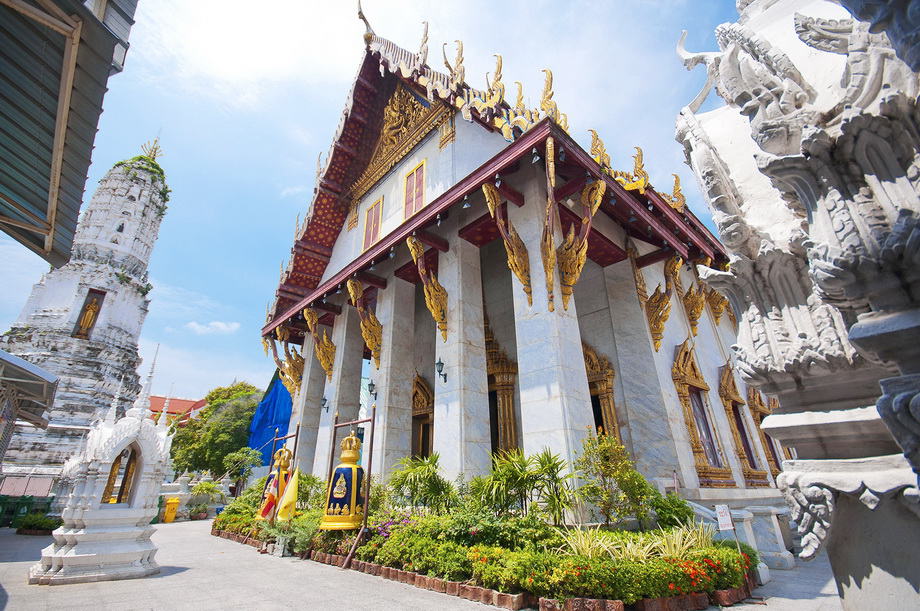
8. Wat Rakang Kositaram - A Key Temple in Religious Outreach
Wat Rakang Kositaram, situated along the Chao Phraya River in the Bang Kok Noi district, is known for its historic significance and association with revered monk Somdej Phutthachao (Toh Promarangsi). The temple was established during the Ayutthaya period and later expanded during the Rattanakosin era.
Wat Rakang’s prominent features include its bell tower and intricate murals depicting Buddhist stories. It has played a crucial role in the dissemination of Buddhism and education in Thailand. Visitors can explore the serene temple grounds and learn about its contribution to religious education and community activities.
Address: Wat Rakang Kositaram 250 Arun Amarin Road, Siriraj, Bangkok Noi, Bangkok 10700
How to get to Wat Rakang:
Chao Phraya Express Boat: Take the Chao Phraya Express Boat and get off at Wat Rakang Pier (Tha Wat Rakang), which is right next to the temple. This is a convenient and popular way to travel to Wat Rakang.
BTS Skytrain: Get off at Saphan Taksin Station and take a ferry across the river to Wat Rakang Pier. From there, you can walk to the temple.
Public Buses: Bus lines passing near Wat Rakang include lines 19, 57, 83, 146, and 149.
Taxi or Private Car: If traveling by private car, use Arun Amarin Road to reach Wat Rakang. Parking is available at the temple's parking lot.
Wat Rakang is located near other important temples such as Wat Arun and Wat Phra Kaew, making it easy to plan a trip covering multiple significant sites in the Thonburi area in a single day.
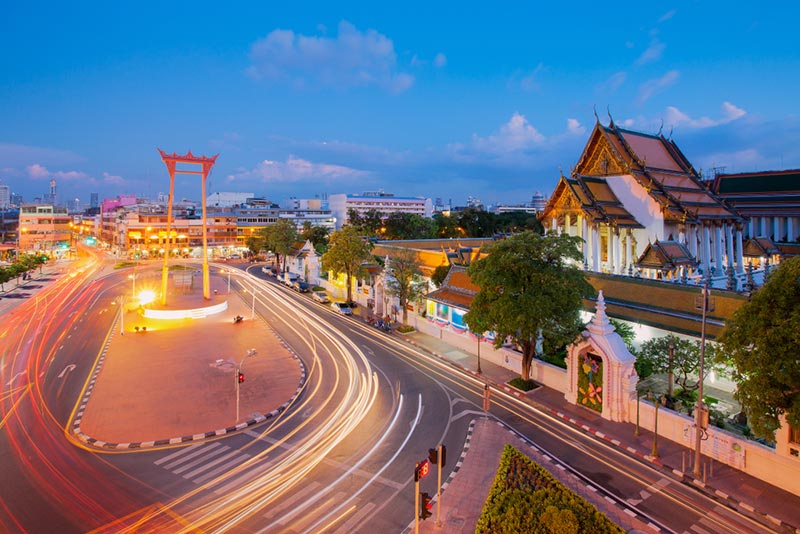
9. Wat Suthat Thepphawararam - Home to Important Buddha Statues
Wat Suthat Thepphawararam, located in the Phra Nakhon district, is renowned for its large and important Buddha statues, including the Phra Buddha Trilokachet. Built during the reign of King Rama I and later expanded under King Rama III, the temple is a key religious site.
The temple’s grand hall features intricate murals depicting Buddhist history and the temple’s architecture reflects the Rattanakosin period’s artistic style. Wat Suthat is a significant site for worship and cultural activities, attracting visitors who come to pay respects to the revered Buddha statues.
Address: 146 Bamrung Mueang Road, Sao Chingcha, Phra Nakhon, Bangkok 10200
How to get to Wat Suthat:
MRT: Get off at Sam Yot Station and walk or take a taxi or public bus to Wat Suthat, which is close to the station.
BTS Skytrain: Get off at National Stadium Station and take a public bus to Wat Suthat.
Public Buses: Bus lines passing by Wat Suthat include lines 12, 15, 35, 42, 47, 73, 96, 508, and 511.
Taxi or Private Car:
If traveling by private car, use Bamrung Mueang Road to reach Wat Suthat. Parking is available at the temple or nearby areas.
Wat Suthat is located in an area with other significant landmarks such as the Giant Swing and Bangkok City Hall, making it convenient to plan a trip to explore multiple important sites in the same area.
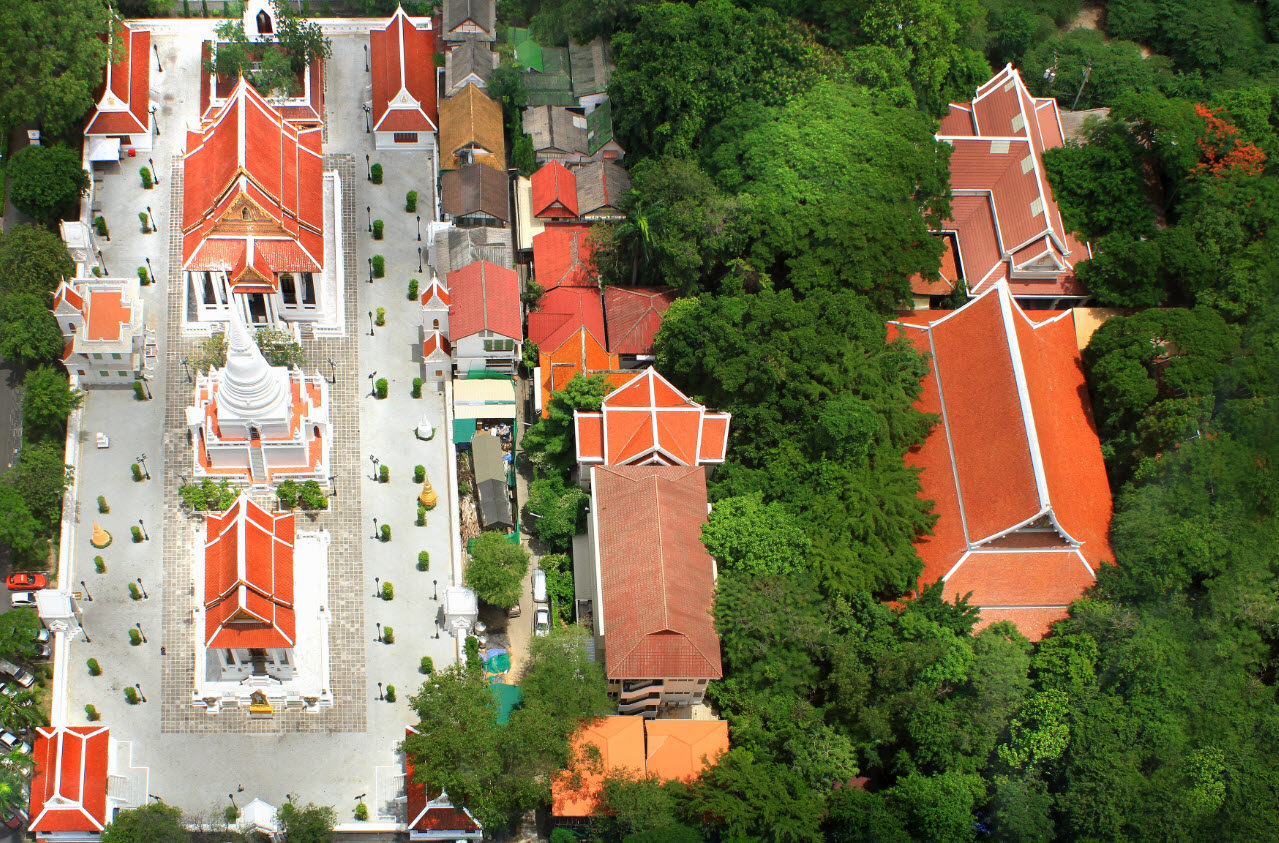
10. Wat Tha Tien - A Riverside Temple
Wat Tha Tien, located on the banks of the Chao Phraya River in the Phra Nakhon district, is known for its historical and religious importance. Established during the Ayutthaya period and later renovated, the temple is famous for its large and beautifully decorated Buddha statues.
The temple plays a significant role in the local community, hosting various religious and cultural events. Visitors can enjoy the tranquil atmosphere and picturesque views of the river, providing a unique experience of Bangkok’s historical and cultural heritage.
Address: 969 Rama I Road, Pathumwan, Pathumwan, Bangkok 10330
How to get to Wat Pathum Wanaram:
BTS Skytrain: Get off at Siam Station or Chit Lom Station and walk to Wat Pathum Wanaram, which is located between Siam Paragon and CentralWorld.
MRT: Get off at Silom Station and transfer to BTS Skytrain at Siam Station or Chit Lom Station, then walk to the temple.
Public Buses: Bus lines passing near Wat Pathum Wanaram include lines 15, 16, 25, 54, 73, 76, 204, 501, and 508.
Taxi or Private Car: Use Rama I Road to reach Wat Pathum Wanaram. Parking is available at the temple’s parking lot or nearby shopping centers.
These important temples in Bangkok offer a deep connection to Thailand’s religious and cultural heritage. Visiting each of these temples provides an opportunity to explore the country’s rich history, experience traditional architecture, and engage in meaningful cultural activities.
Thailand is a country with diverse culture and traditions. Temples play a crucial role as centers of religion and culture, preserving and continuing Thai traditions since ancient times. Temples in Thailand can be categorized into several types based on their characteristics and functions, each with its distinct role and importance.
1. Royal Temples These temples are maintained and supported by the monarchy or government agencies. They are divided into two main categories: Royal Temples of the First Class and Royal Temples of the Second Class.
1.1 Royal Temples of the First Class These temples are of the highest significance in terms of preservation and maintenance, often undergoing restoration by the monarchy. Examples include Wat Phra Sri Rattana Satsadaram (Wat Phra Kaew) and Wat Suthat Thepwararam, which are important sites for religious ceremonies and royal rituals.
1.2 Royal Temples of the Second Class These temples are regularly visited by the monarchy for various ceremonies. They often play a significant role in royal ceremonies and religious activities. For example, Wat Phra Yat Tham is important for its role in organizing and supporting royal ceremonies and rituals.
2. Public Temples These temples are established by the general public for merit-making and religious practice. They vary in characteristics and management, such as:
2.1 Community Temples Located in densely populated areas, these temples often serve as central points for community religious and cultural activities. For example, Wat Chana Songkhram is a significant center for religious and cultural activities in its area.
2.2 Newly Established Temples Typically supported by the community and donations from the public, the management and maintenance of these temples rely on community cooperation.
3. Forest Temples These temples are situated in forested or remote areas. They are important for meditation and simple living, providing places for intensive meditation practice and a simple lifestyle. Monks in forest temples focus on strict meditation practice and spiritual discipline. Examples include Wat Pa Khao Yai and Wat Pa Phu Kha, known for their natural preservation and meditation practices.
4. Urban Temples Located in urban or rapidly developing areas, these temples play an essential role in providing religious services and organizing cultural activities. Urban temples often host various events such as merit-making activities, Buddhist teachings, and community festivals. Examples include Wat Chedi Luang and Wat Phra Chettuphon Wimon Mangkhalaram (Wat Pho), which serve as central hubs for religious and cultural activities in major cities.
5. Abandoned Temples These temples no longer have active religious activities and are often found in rural or old towns where the population has moved away. Abandoned temples may result from population loss or changes in the community, leading to challenges in preservation and maintenance. Examples include Wat Bua Khao, which was once a religious center and meditation site but is now abandoned due to population decline and community changes.
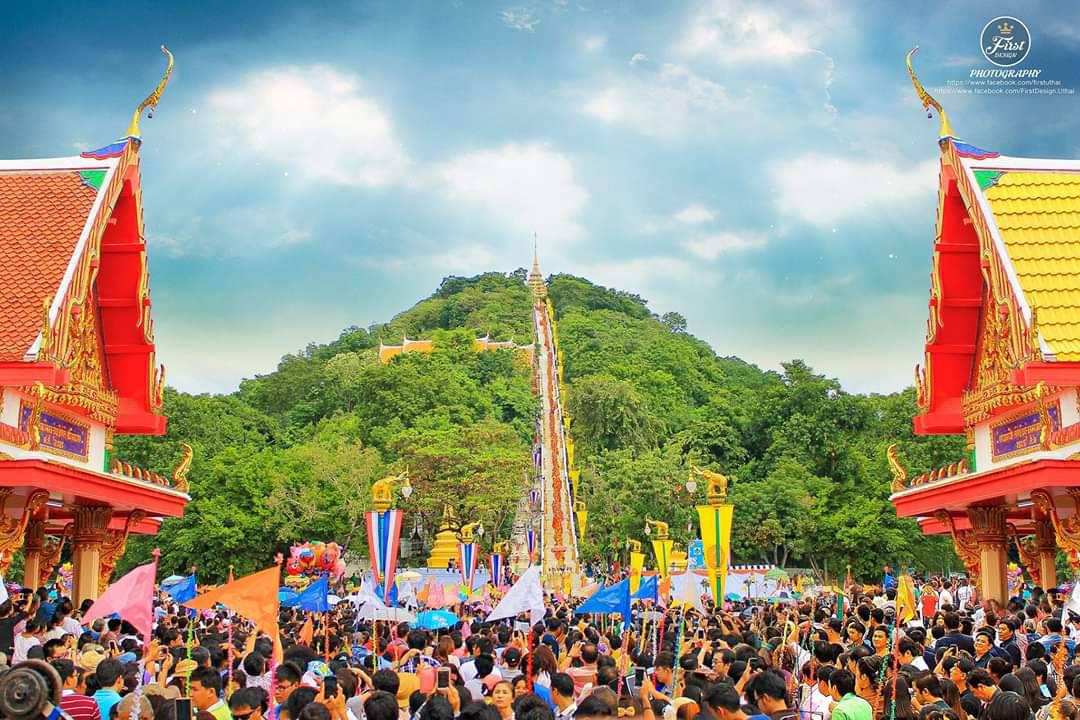
The Importance of Temples in the Daily Life of Thai People Temples hold immense significance in the daily lives of Thai people. They are not only religious centers but also integral parts of the rich cultural and traditional fabric of Thai society. The bond between temples and the Thai people is deeply rooted, making temples more than just places of worship—they are essential to every aspect of life.
1. Temples as Centers of Religious Belief Most Thais are Buddhists, and Buddhism teaches the virtues of doing good deeds and letting go of attachments. Temples are where Thais go to practice meditation, chant, make merit, and listen to sermons. Visiting a temple is not just an expression of religious faith but also a way to find peace of mind and learn the teachings of Buddhism that guide daily life.
2. Temples as Community Centers In many villages, the temple serves as the community’s focal point. It is where people gather for various occasions such as traditional festivals, religious celebrations, or communal merit-making events. Temples also play a key role in fostering unity and cooperation within the community, especially during significant festivals like Songkran or the Buddhist Lent, when people come together for merit-making and shared activities.
3. Temples as Places of Education Temples in Thailand also serve as places for imparting religious and moral education to the public, particularly to children and youth. The study of Dhamma (Buddhist teachings) and the learning of Buddhist practices are instilled from a young age. Ordination as a novice monk or becoming a monk is an important life event for many Thai men, providing them with a deeper understanding of Buddhist teachings and a foundation for leading a virtuous life.
4. Temples as Preservers and Promoters of Culture Temples are also custodians and promoters of Thai culture and traditions. This includes temple architecture, mural paintings, and the organization of traditional merit-making ceremonies. Visiting temples offers an opportunity to connect with and appreciate the cultural heritage that has been passed down through generations. Thus, going to a temple is not only an act of making merit but also a way to engage with the cultural and traditional values that are central to being Thai.
5. Temples as Sanctuaries in Times of Hardship During times of hardship or distress, people often seek solace in temples. Temples offer a place of peace where one can meditate and reflect. Monks provide guidance and counsel, offering solutions to problems based on Buddhist teachings. Therefore, temples serve as a crucial spiritual refuge during difficult times.
Temples are of paramount importance in the daily lives of Thai people, encompassing religious, cultural, educational, and communal aspects. Temples are not just places for worship or meditation, but they are integral to life, connecting people to every facet of their existence. Temples thus stand as symbols of Thai identity, embodying the deep-seated beliefs, faith, and culture of the Thai people.
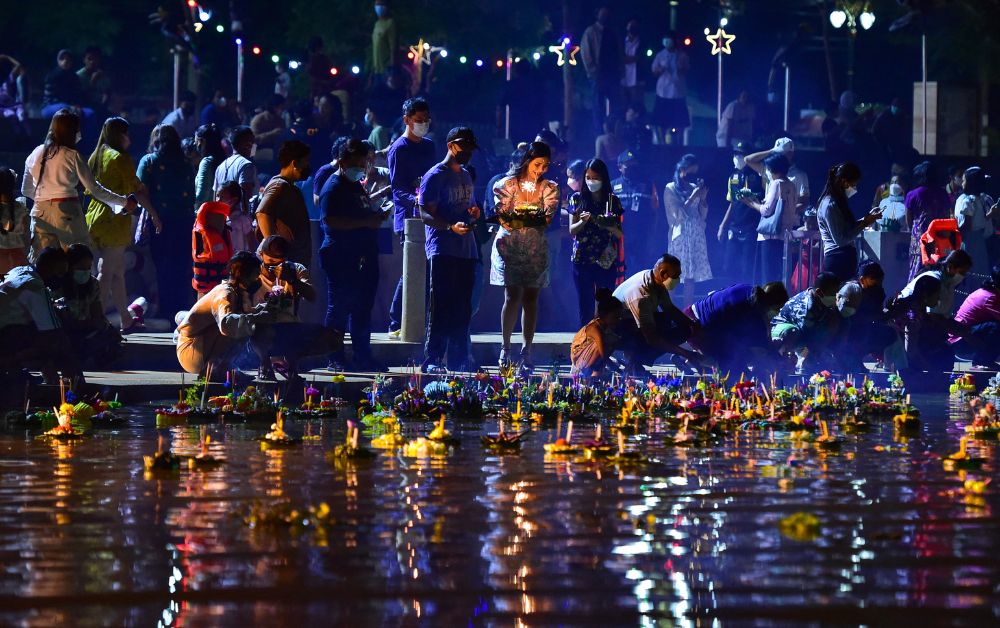
Religious Traditions Related to Temples in Bangkok Bangkok, the capital of Thailand, is home to numerous significant temples. These temples are not only places for religious ceremonies but also serve as the heart of long-standing religious traditions. These traditions reflect the deep respect and faith in Buddhism, as well as the close connection between the Thai people and their cultural heritage. Here are some of the important religious traditions associated with temples in Bangkok:
1. The Candle Procession Tradition At Wat Phra Sri Rattana Satsadaram (Wat Phra Kaew), during the Buddhist Lent, there is often a candle procession. Large candles are paraded and then offered to monks, symbolizing the light of wisdom that guides life during the Lent period. This ceremony is very popular in Bangkok, attracting many participants.
2. The Tradition of Bathing Buddha Statues During Songkran During the Songkran festival, Bangkok residents commonly visit temples like Wat Pho and Wat Arun to make merit and bathe Buddha statues. Bathing the Buddha and monks during Songkran is believed to bring blessings and prosperity for the Thai New Year.
3. The Loy Krathong Tradition At Wat Arun Ratchawararam (Wat Arun), during Loy Krathong, people gather to float krathongs (decorative floats) on the Chao Phraya River. Wat Arun’s beautiful setting makes it a popular place for this festival. Along with floating the krathongs to apologize to the goddess of water, Mae Khongkha, there are also cultural performances and festivities at the temple.
4. The Vesak Tradition At Wat Benchamabophit Dusitvanaram, during Vesak, which commemorates the birth, enlightenment, and passing of the Buddha, a candlelit procession is held around the temple’s main chapel. People carry flowers, incense, and candles, circling the chapel to show reverence and remember the Buddha.
5. The Tradition of Almsgiving on Makha Bucha Day At Wat Saket Ratcha Wora Maha Wihan, on Makha Bucha Day, there is a tradition of offering alms to monks and a candlelit procession around the Golden Mount. People come to make merit and participate in the procession to honor the Triple Gem and incorporate the Buddha's teachings into their daily lives.
6. The Tradition of Gilding Buddha Statues At Wat Bowonniwet Vihara, there is a tradition of gilding Buddha statues, which symbolizes making merit without expecting anything in return and fostering inner happiness. Wat Bowonniwet Vihara is also significant as the royal temple for many Thai kings.
Temples in Bangkok are central to long-standing religious traditions that not only reflect deep respect and faith in Buddhism but also showcase the close ties between the Thai people and their cultural and religious heritage. These temples play a vital role in connecting people with the unique religious traditions that are an integral part of Bangkok's identity.
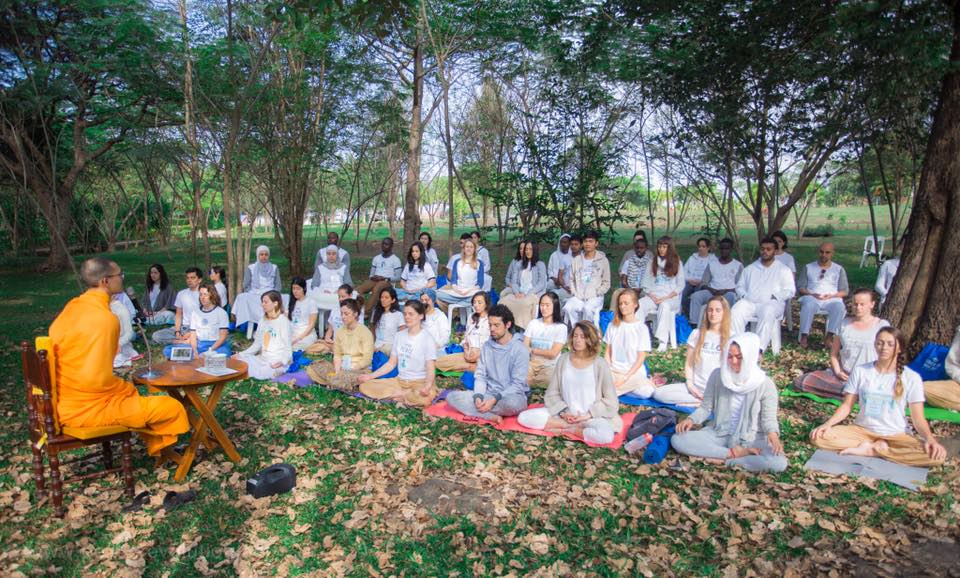
Temples in Bangkok A Center of Long-Standing Religious Traditions Temples in Bangkok serve as centers of long-standing religious traditions that not only reflect reverence and faith in Buddhism but also symbolize the connection between Thai people and their ancestral culture and customs. These temples play a crucial role in linking people with the unique religious traditions of Bangkok.
Practicing Meditation in Bangkok: Learning from Foreign Experiences Meditation practices in Thailand have attracted significant interest from foreigners seeking opportunities to discover inner peace and learn about Buddhist spiritual practices. As a cultural and religious hub, Bangkok boasts numerous temples that welcome foreigners to participate in meditation activities. Here are some experiences shared by foreigners who have joined meditation programs at Bangkok’s temples.
Starting at Wat Bowonniwet Vihara Wat Bowonniwet Vihara is one of the renowned temples in Bangkok that welcomes foreigners for meditation practices. Many participants in its programs report profound and life-changing experiences. Meditation here focuses on understanding the nature of the mind, with participants learning meditation techniques and chanting in the serene environment of the temple.
A visitor from the United States shared, "Meditating at Wat Bowonniwet allowed me to reflect on my thoughts and discover a peace I had never experienced before. Being in such a historically rich temple made the meditation practice even more meaningful."
Experiencing Simplicity at Wat Phra Si Mahathat Wat Phra Si Mahathat is another temple with a meditation program open to foreigners. Participants get to experience a simple lifestyle and practice meditation in a tranquil setting. The focus here is often on mindfulness and meditation to understand the nature of reality.
A participant from Germany commented, "Practicing at Wat Phra Si Mahathat helped me learn about inner peace and how to manage stress in everyday life. I encountered a warm community and received excellent support from the monks."
Living in Wat Suan Dusit offers a more intensive meditation experience for foreigners, with programs that include mindfulness practice and learning about Buddhist teachings. Additionally, participants can engage in learning about the monks' lifestyle and participate in religious activities.
A visitor from France remarked, "Living at Wat Suan Dusit gave me the chance to learn about a simple way of life and deep meditation. I felt that participating in this program opened new perspectives in my life."
Meditation practices in Bangkok offer foreigners a chance to experience a different spiritual journey from their everyday lives. Through meditation, learning about the monks' lifestyle, and participating in religious activities, participants often find that these experiences provide profound meaning and help them discover inner peace that they had not previously encountered.
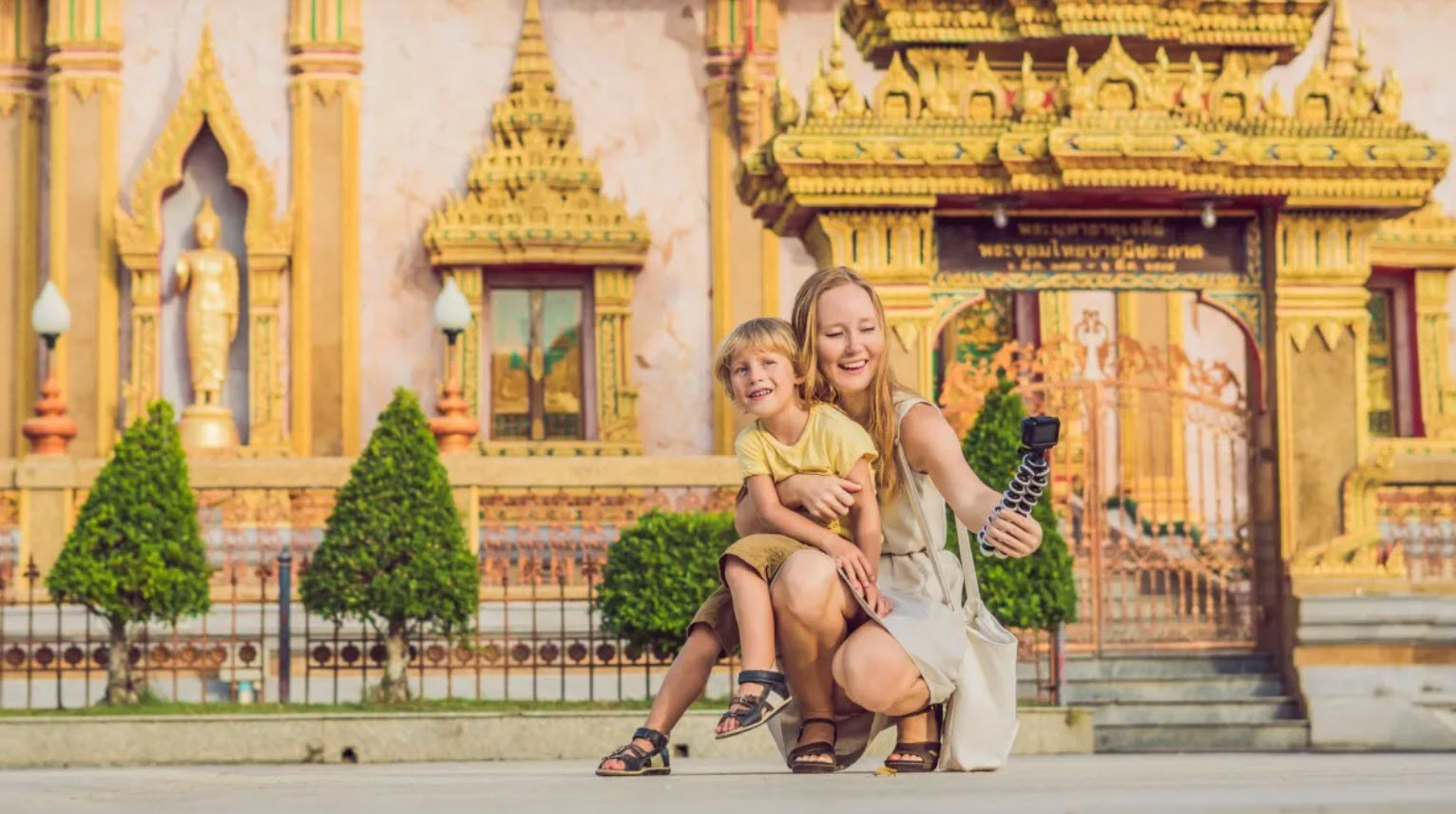
Visiting Temples: Guidelines for Proper Conduct Visiting temples offers a valuable opportunity to learn about religion and culture, but it is essential to adhere to proper conduct to show respect for these sacred places. Here are some key guidelines to ensure your visit is smooth and respectful:
1. Dress Code Wear Long Sleeves and Long Pants/Skirts: Dressing modestly reflects respect for the sacred space. Some temples may have strict dress codes, so it is wise to check the requirements before visiting.
Avoid High Heels: Choose comfortable shoes suitable for walking and avoid shoes that are dirty.
2. Respectful Behavior Remove Shoes Before Entering: Remove your shoes before entering temple areas or places where religious ceremonies take place. Place shoes in designated areas. Maintain Silence: Speak quietly or refrain from talking in areas of worship to avoid disturbing others and to maintain a peaceful atmosphere.
3. Photography Check Photography Rules: Some temples may have restrictions on photography, especially in sacred areas. Check the rules or ask for permission before taking photos. Avoid Restricted Areas: Do not photograph in areas where it is prohibited, such as places of worship or private areas reserved for monks.
4. Meditation or Dharma Practice Respect Dharma Practice: If participating in meditation or Dharma activities, follow the instructions given by monks and respect fellow participants. Be Attentive: Take the opportunity to learn and follow the instructions with focus and intent.
5. Meeting Monks Show Respect to Monks: When interacting with monks, show respect through appropriate gestures such as bowing or saluting. Ask Questions Politely: If you have questions about Dharma practice or other matters, ask respectfully and politely.
6. Maintain Cleanliness Keep the Area Clean: Avoid littering or making the temple area dirty. Use provided trash bins and avoid leaving trash in inappropriate places.
7. Conduct in Worship Areas Avoid Walking in Front of Buddha Statues: Do not stand or walk in front of Buddha statues, as this is considered disrespectful. Do Not Touch Buddha Statues or Sacred Objects: Avoid touching statues or sacred objects unless specifically permitted by monks.
Following these guidelines will not only enhance your experience but also demonstrate respect for the sacredness of the temple and its religious practices. It will also allow you to fully appreciate and engage with Thai culture and traditions.
Comment
| Keyword (Advance) |
 Region
Region
|


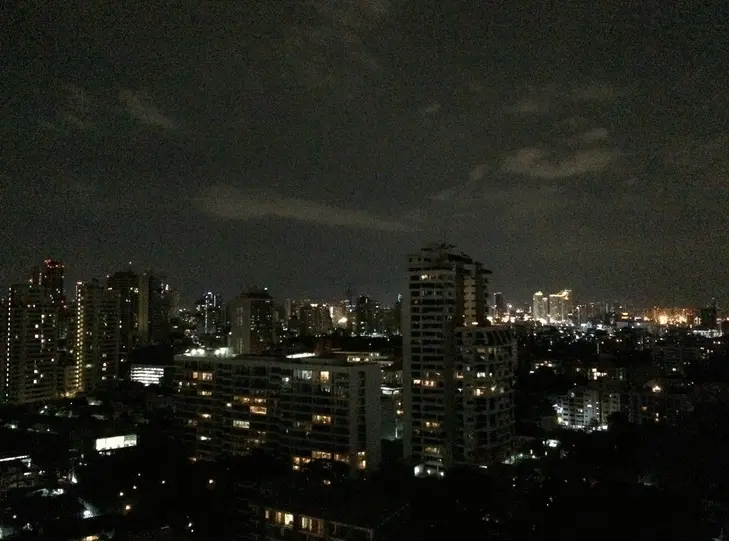
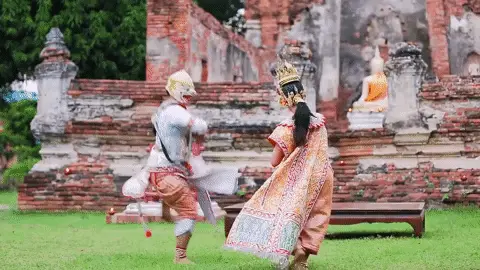
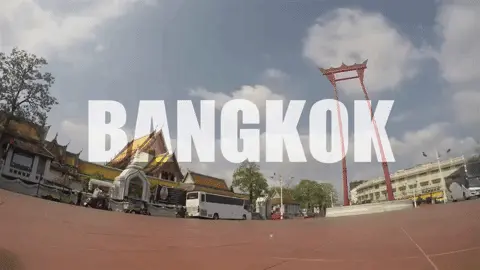


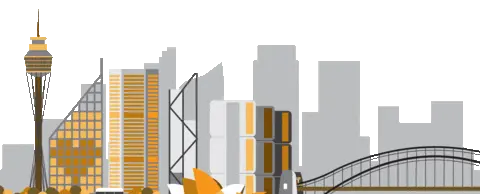
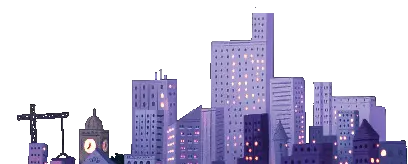
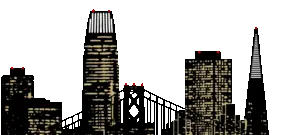




 Category:
Category:  Group:
Group: